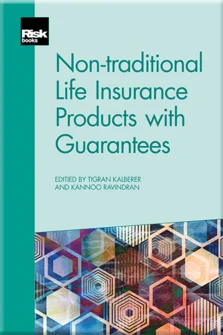How did Variable Annuities Fare in the Crisis?
Peter H Sun and Sam Nandi
Low Interest Rate Environments and Consequences
Risks Faced by Writers of Investment Guarantees
Variable Annuity in Asia post-2008
How did Variable Annuities Fare in the Crisis?
Traditional Life Insurance Products are Under Pressure
An Overview of Regulatory Requirements
Simulations
Economic Scenario Generators and Variable Annuities
Modelling and Managing Policyholder Behavioural Risks
Modelling and Managing Mortality and Longevity Risks
Valuation of Variable Annuity Guarantees
Understanding and Using Reinsurance Treaties for Guaranteed Products
Hedging of Long-term Fund-linked Exotic Options
Overview of Commonly Used Risk Management Strategies
Taxonomy of Equity, Interest Rate, Hybrid and Customised Derivatives Used for Risk Management
Managing Risks Underlying Variable Annuity Liabilities
Basis Risk
Measuring Hedge Effectiveness
Measuring and Reporting Hedge Efficiency
Eight Important Questions Practitioners Should Ask When Managing Equity-linked Insurance Guarantee Risks
The global financial crisis of 2008 and 2009 changed fundamentally many practices in the financial services industry. The effect of the crisis on how variable annuities (VAs) in the US are priced, developed, sold and managed has also been very significant. This chapter will therefore examine the VA industry landscape before and after the financial crisis, and review the key trends post-crisis.
In the period leading up to the financial crisis, the US VA industry was characterised by:
-
- VA sales driven largely by minimum guarantee (GMxB) riders;
-
- multiple VA writers in the VA market;
-
- VA writers engaged in a product feature “arms race” to provide increasingly rich guarantee benefits; and
-
- hedging programmes being established in many, although not all, of the major VA writers.
The financial crisis hit the VA industry by surprise. Due to the dramatic fall of asset prices, almost all GMxB riders became in-the-money in a very short space of time, creating a large increase in reserve and required capital on VA writers’ balance sheets. Fortunately, the hedging programmes already in place proved to be around 93% effective on average
Copyright Infopro Digital Limited. All rights reserved.
As outlined in our terms and conditions, https://www.infopro-digital.com/terms-and-conditions/subscriptions/ (point 2.4), printing is limited to a single copy.
If you would like to purchase additional rights please email info@risk.net
Copyright Infopro Digital Limited. All rights reserved.
You may share this content using our article tools. As outlined in our terms and conditions, https://www.infopro-digital.com/terms-and-conditions/subscriptions/ (clause 2.4), an Authorised User may only make one copy of the materials for their own personal use. You must also comply with the restrictions in clause 2.5.
If you would like to purchase additional rights please email info@risk.net











